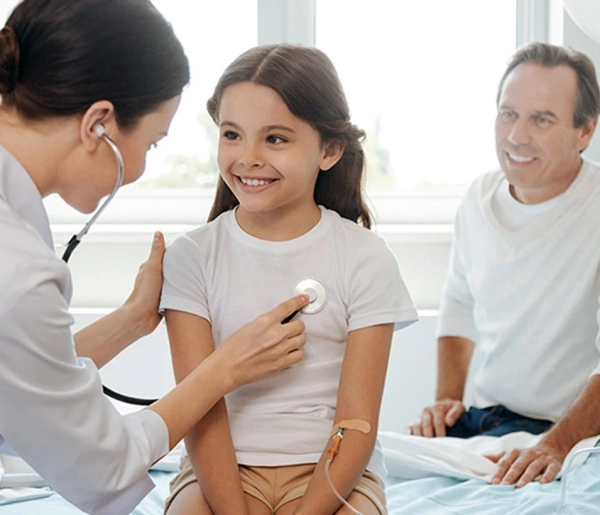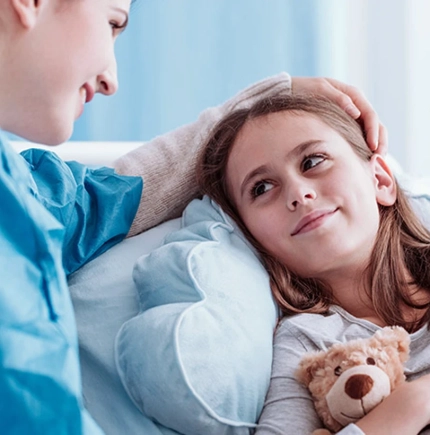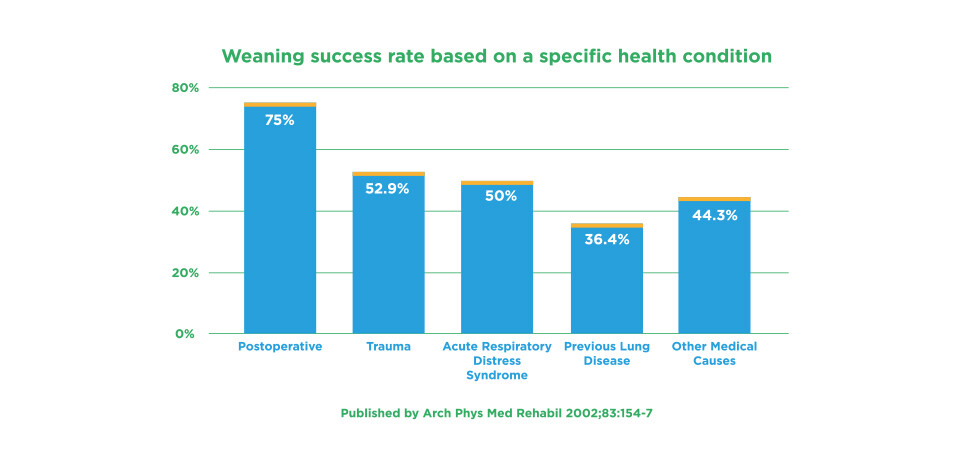Breathing is not that simple for those who suffer from chronic respiratory illnesses, obstructive pulmonary disease, or emphysema. If your child has a respiratory ailment, then you know how big of a struggle breathing can be.
It takes commitment and exceptional care to cope with complex medical conditions like these. That’s where a pediatric rehabilitation program can help. Rehab is designed to boost lung function and well-being so that your little one can keep their breathing in check.
It can aid anyone with chronic breathing difficulties, asthma, pulmonary fibrosis, obstructive pulmonary disease (COPD), and pulmonary hypertension. Here is what you can expect from a pulmonary rehabilitation program.


- Mechanical Ventilation Program
- — Weaning Program
- — Long Term Ventilated Patients
- Post Acute Rehabilitation
- — Neuro Rehabilitation
- — Musculoskeletal Rehabilitation
- — Post Surgeries Rehabilitation
- — Road Traffic Accident
- Pediatric Rehabilitation
- — Speech and Language
- — Neuromuscular Rehabilitation
- — Central Nervous System Anomalies
- — Long Term Care of Cardiac
- — Pediatric Transitional Care
- — Post Acute Care
- Long Term Care & Rehabilitation
- Outpatient Services
- Home Healthcare Services
Cambridge Medical & Rehabilitation Center (CMRC) is a leading provider of pediatric rehabilitation services in the United Arab Emirates and Saudi Arabia. Our state-of-the-art facilities are dedicated to enhancing the quality of life for children through a holistic and interdisciplinary approach.
Cambridge provides an interdisciplinary clinical approach for Pulmonary Rehabilitation.
The best rehabilitation services are not only our goal but our ultimate objective is to customize the care plan for each patient and make sure that the patient’s family and their members are integrated into the treatment plan.
Experience comprehensive care with regular follow-ups, care coordination, and community support at CMRC—where your child’s recovery journey feels like #YourSecondHome.
Pulmonary Rehabilitation in Pediatrics
Pulmonary rehab is a supervised program that focuses on practicing breathing techniques, training, and educating people who suffer from lung problems or conditions.
The goal is to help patients improve their quality of life and learn to breathe with ease, regardless of the lung condition they are living with. A typical pulmonary rehab program in pediatrics incorporates:
- Practical information about your child’s health condition and the ways you can help them breathe easier
- Counseling and support to help you overcome all those emotional boundaries that come with raising a child with serious lung problems
- Training exercises on how to make your child’s body handle their condition to get a healthy energy boost
This program is often recommended to patients after and before lung transplant surgery. It can help them restore their strength, calm the symptoms of depression, anxiety, and help them resume their daily activities.
Any child with severe or moderate lung disease can participate in this program. With the help of a team of respiratory therapists, nurses, doctors, physiologists, and registered dietitians, children will learn to handle their condition and live a healthy life.
According to research, pulmonary rehab offers multiple benefits, especially in asthma patients. To study the impact of this program, researchers evaluated 38 pediatric asthma patients who enrolled in pulmonary rehabilitation.
Based on the reports, 53% were male and 47% female, between the ages of 4 and 19. After treatment, scientists noticed a significant improvement in the way patients managed their chronic asthma.
Because of the dietary counseling and cardiovascular exercises they received, the patients also managed to change their weight and reduce their risk of obesity. All of these benefits play a key role in managing breathing problems in the long-run.
How Does It Work?
Every pulmonary rehabilitation program is unique. They are tailored towards the patient’s needs and are designed to help the parents overcome any health condition. However, all of these programs share typical basic features.
You have:
Patient assessment
The doctor will first have to examine your child’s health state, lung condition, and lifestyle. They will find the cause for the breathing complications, pinpoint the limits, and point out the concerns in your child’s daily routine that might aggravate their condition.
Treatment planning
Every child is different. Some develop more complex health issues and need rigorous treatment, while others will benefit from an easy treatment plan. Your doctor will create a plan that fits your child’s needs. You can then try the plan at home and change any of the old routines that might harm their health state.
Consistent communication
The staff in rehab will constantly monitor your child’s condition. They will analyze the progress and refer you to any additional programs you might need. Constant communication is critical, especially when you are dealing with complicated health issues like these.
Regular sessions
Every child must acquire the knowledge, skills, and abilities to boost their physical and emotional well-being. That’s where regular exercises and class sessions can come in handy. The program gives patients and their parents a chance to better understand lung illness and learn to live with it.
What Happens During Sessions?
Patients must learn to manage their lung condition. To do that, they need the proper skills and knowledge. In class, the program teaches them everything they need to know about their current health state. Why treatment is vital, how to help children cope with symptoms, and ways to monitor their condition.
Another important thing is breathing techniques. By practicing unique techniques, patients learn to soothe their shortness of breath. They can relax and clear the lungs to breathe much easier. In the long-run, this can help them control their emotional state.
They will learn how to handle their stress and ask for help whenever they have a problem with their lung condition. In class, patients also learn about the impact of nutrition. Many people fail to notice the value of healthy food, particularly for lung disease.
But, if patients learn to supply the body with a sufficient amount of nutrients and vitamins, they get to boost their energy, strengthen their muscles, bones, and control their body weight. At-home exercises can prove useful.
Rehab classes provide both patients and parents with all the strategies for a healthy exercise plan. They learn how to manage the condition by staying physically active. Each of these topics is crucial for living a productive life with lung disease. That’s why it’s important to ask for help if you want to stay on the right track.
The idea is to take on a comprehensive approach that’s specifically dedicated to providing patients with a nurturing and safe environment. That way, every child gains access to constant monitoring that would put your mind at ease.
Both parents and children can take part in these activities. Together, they will learn how to engage with one another, help each other, and boost their quality of life. Pulmonary rehab tries to provide a minimally restrictive environment where patients will feel comfortable to achieve their full potential.
Do have in mind, however, that the results of the pulmonary rehab program will vary based on the child’s health state. Some children notice quick results and drastic changes. Others need more time to notice the impact. Consult with a pediatrician to figure out how long it will take your child to notice some results.
Pulmonary Rehab for Mechanically Ventilated Patients
Every sick patient with respiratory problems can restore their lungs to a functional state as much as possible. But, if the health condition is too severe, they will need additional support. That’s where mechanical ventilators can help.
These devices are designed to help strengthen the system and return patients to a more independent lifestyle. Rehabilitation for mechanically ventilated patients is a lot more complex than non-ventilated patients.
It requires the teamwork of multiple disciplines, like a physical therapist, dietician, occupational therapist, speech pathologist, physician, pulmonary CNS, etc. The goal is to work together, and coordinate their efforts for ideal results, explains the National Library of Medicine.
The therapy will change based on the patient’s daily tolerance and assessment. Medical experts will need to constantly communicate to come up with the ideal approaches to enhance the quality of life and promote autonomy and independence.
Pulmonary rehab may need to use a weaning process and teach patients to function productively. Depending on how severe chronic respiratory failure might be, young patients might have to rely on ventilator assistance chronically.
Chronic Respiratory Failure (Vent & Non-Vent Patients)
- The purpose of ventilation therapy is to regulate the partial pressure of carbon dioxide (PaCO2) in the blood
- Non-invasive ventilation therapy is used when patients experience chronic hypercapnia as well as other symptoms of respiratory failure. The hypercapnia lasts over two weeks and requires ventilation treatment
- Invasion ventilation therapy is used when non-invasive therapy can’t help. Patients have chronic respiratory failure, weaning, or must rely on intubation done to get the air flowing
When a patient needs long-term treatment, like it is the case with chronic respiratory failure, they will need to receive proper oxygen therapy that can resupply the blood with healthy oxygen levels.
Today, non-invasive and invasive mechanical ventilation are the go-to choice for treating this health condition. The aim of both of these therapies is to normalize the ventilation by providing patients with the best therapeutic effects they can get.
The idea is to relieve the respiratory pressure or control the ventilation in case the airway collapses during sleep.
Vent and non-vent patients enjoy a spontaneous breathing frequency, boost lung function, reduce blood gases, and volume trauma. That way, they get to improve their physical performance, resilience, oxygenation, and dyspnea. Many patients who’ve received mechanical ventilation have managed to improve their quality of sleep.
Indications for Ventilation
There are many reasons patients get mechanical ventilation. This is a life-support technology for those who are unable to breathe on their own. Only a doctor can determine whether your child has reduced ventilation.
But, the primary indications are:
- Acute respiratory acidosis
- Refractory hypoxemia
- Shock
- Inability to remove secretion on their own
- Recently diagnosed with a neuromuscular illness
- Short-term ICP (increased intracranial pressure)
The ventilation will be modified based on the expiratory pressure, oxygen concentration, and respiratory rate. The therapy will control continuous breathing and assist with airflow. The goal is to control the gas exchange and minimize the risk of ventilator-induced lung damage.
The patient will feel immediate relief since the ventilation will reduce the obstruction in the lower and upper airways. Thus, providing them with much-needed respiratory fatigue relief. Plus, the airways remain protected, and the lungs will function properly.
Of course, there is a limit to how much support these ventilators can give. Their effect is determined by the pressure and volume used. Each respiratory problem needs a different amount of airflow.
Doctors will focus on protecting the lungs with adequate air management strategies. They will fine-tune the ventilation depending on the oxygen saturation and blood gases. They will control the pressure and monitor the airways.
Ventilation Dependent Patients (Weaning Program)
Weaning is a process that liberates the patients from the endotracheal tube and any mechanical support. Parents are often concerned about the whole process. They are unfamiliar with the method and have no clue what to expect.
Weaning can cause numerous changes in the nervous system. It can affect heart rate, quality of sleep, handgrip, oxidative stress, etc.
Patients need to meet certain criteria to see if they are ready for weaning. That’s why doctors will do a subjective and objective assessment (like heart status, coughing, blood pressure, and so on.) Every weaning problem is different.
Multiple conditions affect ventilator modes. But, overall, here is how the program looks like, according to the European Respiratory Journal:
- Patients are categorized into groups based on their health state, duration, and difficulty of the weaning process
- The mechanical respiration is carefully removed
- Doctors try a breathing trial to see if the process worked. It lasts for about 30 min and focuses on the pressure support and the patient’s breathing
- If patients fail the trial, doctors will use pressure support ventilation modes to get the breathing under control
- To reduce the duration of intubation, some patients may require non-invasive ventilation.
Simply put, weaning is the key to caring for critically ill patients. Since it removes the mechanical support, it helps patients feel independent. However, this is a very complex process that requires constant cooperation and monitoring to make sure the illness is not causing any serious problems for the patient.
How Effective Is It?
Weaning has a relatively high success rate. Based on a study, 50% of patients who received a ventilator were weaned successfully. Overall, the success rate is higher than 50%, published the Archives of Physical Medicine and Rehabilitation.
If a patient is dealing with malnutrition or has a poor nutritional status, the weaning success rate can plummet. This is a detailed analysis of the weaning program’s success rate based on each unique health condition.

Weaning has a relatively high success rate. Based on a study, 50% of patients who received a ventilator were weaned successfully. Overall, the success rate is higher than 50%, published the Archives of Physical Medicine and Rehabilitation.
If a patient is dealing with malnutrition or has a poor nutritional status, the weaning success rate can plummet. This is a detailed analysis of the weaning program’s success rate based on each unique health condition.
When Can a Mechanical Ventilation Be Removed?
After assessing ventilator dependence, a doctor will remove the mechanical ventilation. To remove the ventilation, a patient must be clinically stable. That means they need to have a high tolerance and breathe independently. Otherwise, the ventilation will be reintroduced. The doctor will determine if the patient is ready to have the ventilation removed.
How Long It Takes to Wean a Patient off a Ventilator?
The typical time for ventilator liberation depends on the type and severity of disease or lung damage. But, in most cases, it can range between 30 to 180 after the intubation has been inserted. If the patient has a hard time becoming independent, they may need to keep using the ventilator for more than 180 days.
What Are the Criteria for Inpatient Admission?
An inpatient pediatric rehab unit provides interdisciplinary and comprehensive treatment for adolescents and children. To qualify for a pediatric rehabilitation program, patients need to fill certain criteria. They need to require rehabilitation services.
If they suffer from any underlying health condition, for example, obstructive pulmonary disease, they can be eligible for a program.
These serious medical illnesses require intensive treatment. But first, patients need to participate in a couple of hours of daily therapy. A doctor can evaluate your child’s health state and let you know if inpatient treatment is the ideal alternative.
How Do Patients Get Prepared for a Ventilator?
According to experts, patients first get emotionally and physically prepared before they start the ventilation. Then, they will receive local anesthesia and sedatives to make sure the procedure goes as smoothly as possible. The circuit will be attached to the endotracheal tube, and patients can receive proper airflow. The ventilator will provide the arteries with oxygen and promote healthy ventilation.
Can Children Become Dependent on a Ventilator?
Some individuals do become dependent on mechanical support because of a serious health complication. In these patients, weaning can be difficult. They will also have trouble speaking or doing any of their regular activities.
Learning to live with respiratory problems is no easy feat, especially for younger patients. That’s where a pediatric rehab program can help. It specializes in managing, treating, and educating children and their parents on how to overcome difficult medical problems like these.
The goal of this program is to maximize the recovery process, independence, restoration, and development in young patients. Medical experts will also use this opportunity to educate and assist parents, regardless of how complex the health condition might be.
What’s important is that you seek on-time treatment and learn to understand your child’s health condition. With pediatric rehabilitation, you can achieve exactly that.